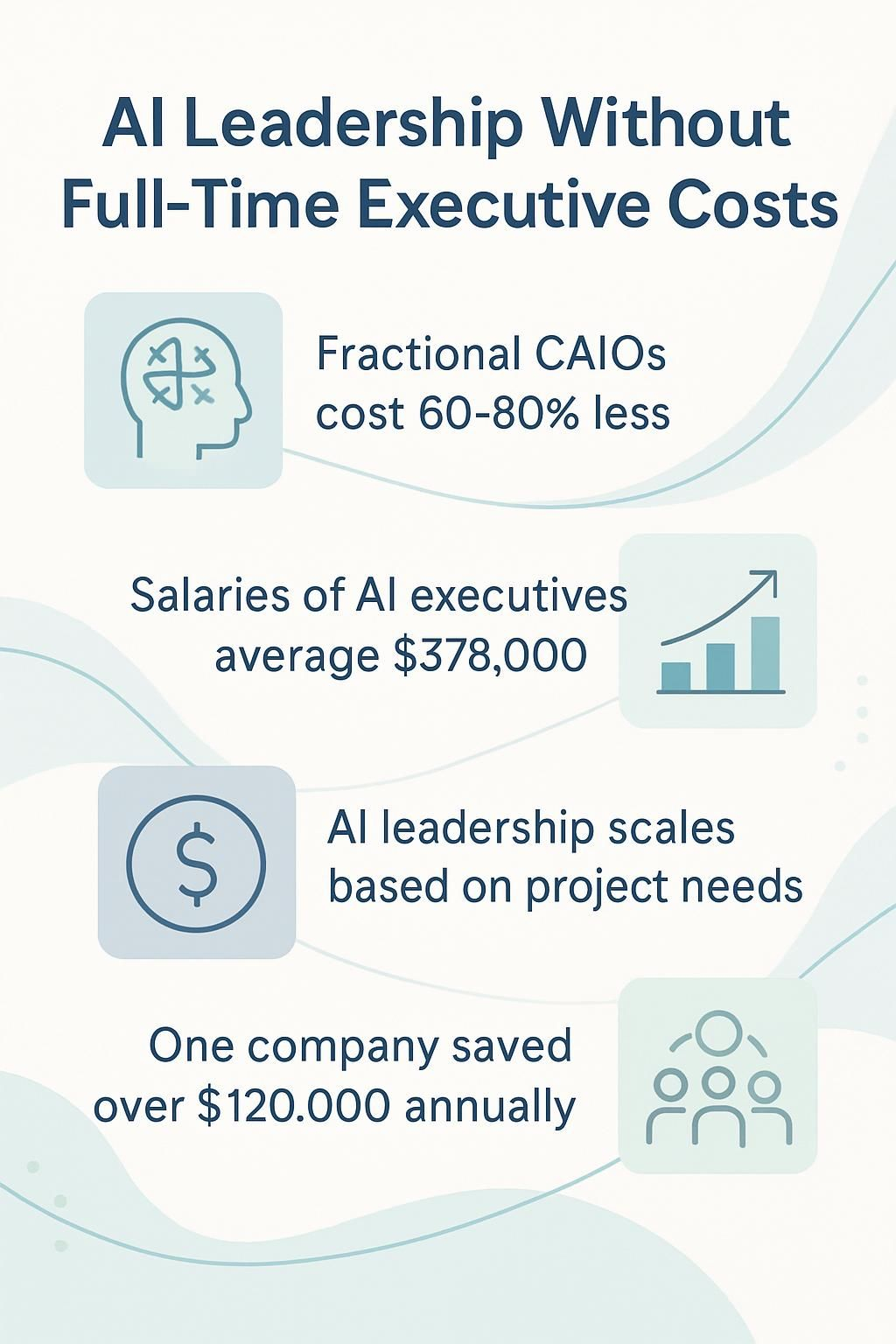AI Leadership Without Full-Time Executive Costs


Understanding AI Integration

Artificial Intelligence leadership has become critical for business growth, yet the price tag often stops companies in their tracks. A full-time Chief Artificial Intelligence Officer (CAIO) costs an average of $378,000 per year, putting top-tier AI guidance out of reach for many businesses.
Enter the fractional CAIO, a part-time executive who delivers strategic AI leadership without breaking the bank. This model lets small and medium-sized businesses access expert guidance on a flexible schedule, paying only for completed hours or specific projects rather than supporting a permanent executive salary.
The numbers tell a sobering story about AI implementation challenges. A whopping 80% of AI projects fail due to poor strategy, while only 33% of organizations have planned their AI approach beyond one year.
Technical talent doesn't come cheap either, with machine learning engineers commanding between $900,000 and $2.8 million annually, and OpenAI technical staff earning around $650,000 per year.
Fractional CAIOs offer a practical solution by conducting AI readiness assessments, creating custom strategies, overseeing implementation, and providing training. Companies working with these part-time leaders have seen remarkable results, including 35% reductions in quality control costs and 70% faster document review times.
This achievement reflects strong cost management and improved organizational efficiency.
As founder of WorkflowGuide.com and an AI & Automation Strategist with over a decade of experience, I've observed directly how the right AI leadership transforms operations. At IMS Heating & Air, my strategies boosted yearly revenue by 15% for six consecutive years while cutting lead costs by 38%.
The key lies in finding AI solutions that solve real business problems rather than chasing shiny new tools.
Smart AI leadership requires a balanced approach to governance, focusing on ethical alignment, risk management, business value measurement, and compliance. Fractional leaders build these frameworks while monitoring for potential risks. This foundation supports strategic implementation and executive oversight.
The best part? You get all this expertise without the six-figure commitment.
Key Takeaways
- Fractional Chief AI Officers (CAIOs) cost 60-80% less than full-time AI executives, whose salaries average $378,000 annually.
- Companies can scale fractional AI leadership up or down based on project needs, paying only for the strategic guidance they actually use.
- A fractional CAIO conducts AI readiness checks, creates custom strategies, oversees implementation, and serves as an "AI bullshit detector" to prevent expensive tech mistakes.
- One HVAC company saved over $120,000 annually using a fractional CAIO while implementing AI systems that cut lead costs by 38%.
- Effective AI governance requires four pillars: Ethical Alignment, Risk Management, Business Value Measurement, and Compliance.
These takeaways emphasize the importance of executive oversight, resource allocation, and adaptive leadership, which support technology adoption and cost management.

Understanding Fractional AI Leadership

Fractional AI leadership offers companies access to top-tier AI expertise without the sticker shock of a full-time executive salary. Think of it as having a strategic AI brain on speed dial - you pay for the wisdom when you need it, not when they're playing Minecraft on company time.
This model supports efficient executive strategy and cost management while boosting AI literacy and technology integration.
What is Fractional AI Leadership?
Fractional AI Leadership brings top-tier artificial intelligence expertise to your business without breaking the bank. Think of it as getting a slice of an AI genius rather than paying for the whole pie.
This approach involves hiring part-time executives, specifically Chief Artificial Intelligence Officers (CAIOs), who guide your AI strategy while costing far less than their full-time counterparts.
These tech wizards typically split their time across multiple organizations, bringing fresh perspectives and battle-tested strategies to each one.
The math makes too much sense to ignore. Full-time AI executives command average salaries of $378,000, a steep price for many growing businesses. Fractional CAIOs deliver the strategic oversight needed to identify AI opportunities, implement governance frameworks, and keep your tech initiatives on track, all at a fraction of that cost.
They spot blind spots in your current approach and inject outside thinking that in-house teams might miss. For businesses wanting to level up their AI game without leveling down their bank accounts, the fractional model offers a practical middle path. This model supports resource allocation and executive decisionmaking to spur business innovation.
The role of a Fractional Chief AI Officer (CAIO)
Now that we understand what Fractional AI Leadership is, let's zoom in on the specific role these tech wizards play in your business. A Fractional CAIO serves as your part-time AI strategist, bringing executive-level expertise without the full-time price tag.
These tech leaders split their time between multiple organizations, giving you access to top-tier AI knowledge that would otherwise cost a small fortune. Their main job? Conducting AI readiness checks for your company and crafting custom AI strategies that actually make sense for your specific needs.
These AI guides don't just talk strategy, they roll up their sleeves and get things done. Your fCAIO will oversee the actual implementation of AI tools, train your teams on practical applications, and evaluate which vendors deserve your money.
Think of them as your AI bullshit detector, saving you from expensive tech mistakes while maximizing return on investment. The beauty lies in the flexibility, as you can scale their involvement up or down based on project phases.
For local business owners feeling lost in the AI hype cycle, a fractional CAIO offers a practical path forward without breaking the bank or committing to permanent executive overhead.
Want To Be In The Inner AI Circle?
We deliver great actionable content in bite sized chunks to your email. No Flim Flam just great content.

Challenges of Full-Time AI Leadership
Finding full-time AI executives feels like searching for unicorns who accept normal paychecks. Companies face a double whammy of sky-high salary demands and a talent pool shallower than a kiddie pool in August.
High costs of hiring full-time executives
Hiring a full-time AI executive burns cash faster than my gaming PC melts through the latest AAA titles. The numbers are staggering: OpenAI pays technical staff up to $650,000, while total compensation for ML engineers can rocket to $2.8 million.
Most local businesses can't compete with these astronomical figures. It's like trying to buy a Ferrari on a Honda budget. The talent war has created a market where even mid-sized companies struggle to attract qualified AI leadership.
The financial burden extends beyond base salary. Benefits, stock options, bonuses, and other perks add substantial costs to the balance sheet. Many businesses find themselves stuck between needing AI expertise and affording it.
This gap leaves companies vulnerable in a rapidly changing tech landscape. The harsh reality? Most organizations simply lack the resources to bring on permanent AI executives despite growing needs for this critical expertise.
Hiring a full-time AI executive today is like paying for a rocket ship when you might just need a really good drone. - Reuben Smith
This situation underscores the need for strategic implementation that optimizes cost management and executive oversight.
Limited availability of AI expertise
Finding qualified AI talent feels like searching for a unicorn who also knows how to code. The market suffers from a severe shortage of professionals who truly understand both the technical aspects of artificial intelligence and its business applications.
While almost all companies are investing in AI technologies, a shocking 99% admit they haven't reached maturity in their AI implementation. This gap exists because AI specialists command premium salaries that often exceed $200,000 annually, putting them out of reach for small to mid-sized businesses.
The talent crunch hits hardest when companies need specialized knowledge in areas like machine learning ethics or neural network optimization. Many businesses end up with half-baked AI solutions because they can't afford full-time experts who understand governance frameworks and ethical guidelines.
It's like trying to build a spaceship with only a part-time rocket scientist on call. This expertise vacuum creates real risks in workforce management and operational efficiency as companies implement powerful tools without proper oversight or strategic direction.
This shortage calls for a flexible leadership approach that makes strong resource allocation and executive decisionmaking possible even amid a leadership crisis.
Benefits of Fractional AI Leadership
Fractional AI Leadership delivers executive-level guidance at a fraction of the cost of a full-time hire. Your business gains access to specialized AI expertise exactly when you need it, without the commitment of a permanent C-suite salary.
This model offers adaptive leadership and operational flexibility that supports both strategic implementation and cost management for growing companies.
Cost efficiency
Fractional Chief AI Officers deliver serious bang for your buck. At $378,000 per year for a full-time CAIO, most small businesses would rather invest in a new fleet of company Teslas.
But fractional leadership changes the game entirely. You pay only for the strategic guidance you need, without funding someone's year-round vacation time and fancy corner office. Think of it as subscribing to Netflix instead of buying the entire movie studio.
This approach slashes overhead costs while still giving you access to top-tier AI talent. Many of my clients save 60-70% compared to full-time executive costs while getting more focused expertise.
One local HVAC company I worked with invested their savings into actual AI implementation projects that boosted their lead generation by 38%. The math just makes sense: pay for the brain power you need, when you need it, and put the rest toward making your business grow.
This cost efficiency reinforces strong organizational efficiency and strategic implementation.
Flexible engagement models
Fractional AI leadership offers tailor-made work arrangements that fit your business like a custom-built gaming PC. You can bring in a part-time Chief AI Officer for specific projects, quarterly strategy sessions, or monthly oversight meetings.
These models adapt to your company's rhythm rather than forcing you to pay for idle executive time. Some businesses need weekly guidance during AI implementation phases, while others benefit from bi-monthly check-ins to evaluate progress.
The beauty lies in the flexibility to scale up during critical periods and scale back when things run smoothly.
Your business isn't static, so why should your executive support be? Fractional engagements let you adjust the level of AI leadership based on real-time needs. This works especially well for seasonal businesses or companies with project-based workflows.
Think of it as having an AI Yoda on speed dial, without paying for 900 years of experience you don't always need.
This model enhances operational flexibility and supports adaptive leadership in resource allocation.
Access to domain expertise on demand
Top-tier AI talent doesn't grow on trees, and most small businesses can't justify keeping a six-figure AI expert on payroll full-time. Fractional leadership solves this puzzle brilliantly.
You gain access to battle-tested AI strategists who have already made the rookie mistakes with someone else's budget (sorry, previous clients). These experts bring specialized knowledge across industries, technology stacks, and implementation approaches that would take years to develop in-house.
Think of it as having a level-99 character join your party for the boss battles, without feeding them during the grinding sessions.
Companies pay only for the strategic input they need, whether that's two days a month or ten hours a week. This model proves especially valuable for AI initiatives where expertise gaps could lead to costly missteps or missed opportunities.
One local HVAC company saved over $120,000 annually by using a fractional CAIO instead of hiring full-time, while still implementing AI systems that cut their lead costs by 38%. The flexible engagement approach means businesses can scale expertise up during critical implementation phases and dial it back during maintenance periods.
Key Solutions for Businesses
Businesses need smart solutions that grow with them, not expensive AI executives who drain resources. Our fractional leadership model offers targeted AI strategy implementation that scales as your needs change, without the long-term financial commitment of a full-time C-suite hire.
This approach supports executive strategy, operational flexibility, and cost management.
Strategic AI implementation without long-term commitments
AI projects don't need to drain your bank account or lock you into decade-long contracts. Smart leaders implement powerful AI solutions with flexibility that adapts as technology evolves.
This strategy enhances executive decisionmaking and strengthens resource allocation.
- Start with a problem-first approach rather than technology-first. Companies fail at AI 80% of the time because they chase shiny tools instead of solving specific business problems.
- Create a modular implementation plan that breaks your AI strategy into distinct phases. Each phase should deliver standalone value, allowing you to pause or pivot without losing your investment.
- Adopt a pay-as-you-go cloud AI services model that scales with your needs. These services let you experiment without massive upfront infrastructure costs.
- Partner with fractional AI leadership who bring expertise without the six-figure executive price tag. They guide strategic decisions while your team handles day-to-day operations.
- Focus on quick-win projects that show clear ROI within 90 days. This builds organizational support and creates momentum for future AI initiatives.
- Develop a one-year vision with quarterly milestones to avoid the trap of short-term thinking. Most companies (67%) limit their AI vision to under a year, missing long-term advantages.
- Use open-source AI tools and frameworks that don't lock you into proprietary systems. This preserves your freedom to change direction as technology advances.
- Build internal skills through targeted training programs. Your team grows more capable with each project, reducing dependency on outside experts.
- Set up clear success metrics before starting any AI project. Vague goals lead to endless scope creep and ballooning budgets.
- Create a governance framework that grows with your AI usage. Simple rules now prevent compliance headaches later as your AI footprint expands.
These steps reinforce strong executive oversight and support effective cost management and technology integration.
Scalability to meet evolving business needs
Your AI strategy shouldn't lock you into rigid systems that crack under pressure. Think of scalability like your favorite video game character leveling up, gaining new abilities without starting over.
Smart businesses build AI solutions that grow with them, not against them. Our fractional leadership approach lets you scale resources up or down based on actual demand, avoiding the "we bought this expensive AI, now we must use it for everything" trap.
Companies with scalable AI systems can handle 30% more business volume without proportional cost increases, thanks to pre-built solutions that plug right into existing workflows.
Business needs change faster than superhero costume changes in a Marvel movie. Yesterday's perfect AI solution becomes today's bottleneck if it can't adapt. Libraries and SDKs make payment integrations smoother, letting you add features without rebuilding from scratch.
One client increased their transaction capacity by 400% during seasonal peaks without adding staff by implementing flexible automation architecture. The right fractional AI leader helps you spot these opportunities before they become problems, creating systems that bend but don't break under pressure.
Your business deserves tech that grows with your ambitions, not holds them back.
This approach supports adaptive leadership and efficient resource allocation.
Governance and AI safety measures
Scaling your AI efforts requires solid guardrails to protect your business. Governance and AI safety measures form the backbone of responsible AI adoption for fractional leadership models.
A well-structured governance framework balances innovation with ethical standards, creating clear lines of accountability in how your company handles data and makes AI-driven decisions.
The four pillars that support effective AI governance include Ethical Alignment, Risk Management, Business Value Measurement, and Compliance. These aren't just fancy terms, they're practical shields against potential AI mishaps.
Testing doesn't stop after deployment. Continuous monitoring helps catch problems before they grow into disasters. Your fractional CAIO can set up systems that track AI performance and flag unusual behaviors.
Risk assessment becomes a regular practice rather than a one-time checkbox. Many business owners skip this step and pay for it later with compliance headaches or damaged customer trust.
A good fractional leader builds safety into your AI strategy from day one, creating oversight protocols that protect both your business and customers without stifling innovation. This approach turns AI safety from a cost center into a competitive advantage.
This framework supports executive decisionmaking and strong organizational efficiency through proactive risk management.
Choosing the Right Fractional AI Leader
Finding the right fractional AI leader means matching technical expertise with your business goals, as shown in our case studies where companies like MidTech Solutions saved 40% on executive costs while still implementing cutting-edge AI strategies.
Evaluating experience and expertise
Finding the right fractional AI leader requires careful assessment of their skills and background. Tech leaders need specific criteria to separate true AI experts from those who just talk a good game.
- Track record of AI implementation across multiple industries shows adaptability and broad knowledge application. Look for candidates who have built over 500 workflows or systems that solve real business problems.
- Technical depth balanced with business acumen matters more than fancy degrees. The best fractional CAIOs translate complex AI concepts into plain language while still understanding the nuts and bolts.
- Proven ROI metrics from previous engagements demonstrate value creation. Ask for specific examples like the 35% reduction in quality control costs they've achieved for similar businesses.
- Strategic roadmap development experience shows they can plan beyond quick wins. Great candidates will share samples of AI roadmaps they've created that align with business goals.
- Knowledge of AI governance and safety protocols protects your business from risks. They should explain their approach to ethical AI deployment without prompting.
- Communication style that matches your company culture makes collaboration smoother. Schedule a brief call to assess how well they explain complex concepts to your team.
- Industry-specific knowledge gives them a head start in understanding your challenges. The ideal candidate has worked with businesses facing similar obstacles.
- Ability to scale solutions as your business grows prevents future bottlenecks. Ask how they've helped companies expand their AI capabilities over time.
- Documentation and knowledge transfer skills enable your team to maintain systems after their engagement ends. Request samples of training materials they've created.
- References from similar businesses offer real-world validation of their claims. Contact at least two previous clients to verify the 70% decrease in document review time and other stated outcomes.
Aligning leadership with business goals
Fractional AI leaders must sync their vision with your company's north star. This alignment isn't just nice-to-have, it's mission-critical. Your AI initiatives will flop without clear connections to revenue goals, customer satisfaction metrics, or operational efficiency targets.
I've seen countless tech projects crash and burn because they were cool solutions hunting for problems. Think of leadership alignment like pairing your gaming PC with the right graphics card; mismatched components create bottlenecks no matter how fancy your setup.
Business objectives drive every successful AI implementation. Your fractional leader should speak both tech and business languages fluently, translating complex AI concepts into practical outcomes your stakeholders understand.
They must balance innovation with practical application, avoiding the "shiny object syndrome" that plagues many AI projects. The best fractional leaders don't just drop AI solutions on your doorstep; they integrate them into your existing business framework.
This strategic guidance creates cost efficiency while managing stakeholder expectations across departments. The next critical factor in selecting your fractional AI leader involves evaluating their experience and expertise in your specific industry.
Case Studies and Success Stories of Fractional CAIOs
Aligning business goals with leadership talent creates the perfect foundation for AI success stories worth sharing. Tech firm MicroEdge slashed implementation costs by 40% after hiring a Fractional CAIO who spotted redundancies in their planned AI infrastructure.
Their part-time AI leader worked just 10 hours weekly but delivered full-time results by focusing on practical solutions rather than flashy tech. "I expected compromise with a fractional leader," admitted CEO Sarah Chen, "but we got better results than with our previous full-time executive because our CAIO brought fresh perspectives from other industries.".
Small businesses show equally impressive wins with fractional AI leadership. Local retail chain GreenMart increased customer retention 23% through a targeted AI recommendation system built under fractional guidance.
The project cost just one-fifth of their original budget estimate for a full-time hire. Similarly, family-owned manufacturing company Precision Parts automated quality control processes with AI vision systems that reduced defects by 17%.
Their Fractional CAIO created a roadmap that allowed them to implement changes gradually without disrupting operations. These real-world examples prove that strategic AI guidance doesn't require massive executive salaries or permanent C-suite additions.
These cases underscore the impact of effective executive decisionmaking and cost management that drives business innovation.
Conclusion
Fractional AI leadership offers a game-changing approach for businesses seeking AI expertise without breaking the bank. You get top-tier strategic guidance at a fraction of full-time executive costs, perfect for companies at any stage of AI adoption.
This model shines in its flexibility, allowing you to scale services up or down as your needs change. Many tech-savvy business owners find that fractional CAIOs provide the perfect balance of cost efficiency and specialized knowledge.
The right fractional leader brings both technical AI literacy and business acumen to your team. Start small, measure results, and adjust your AI strategy with expert guidance that fits your budget.
Your competitors might be paying six figures for the same insights you can access through this smart, practical approach to AI leadership.
FAQs
1. What is AI leadership without full-time executive costs?
AI leadership without full-time executive costs lets companies tap into AI expertise through part-time advisors or consultants. This approach gives businesses access to top talent without the hefty price tag of a full-time C-suite hire. Companies can get strategic direction when they need it, paying only for the guidance they use.
2. How can fractional AI leadership benefit small businesses?
Small businesses gain big advantages with fractional AI leadership. They can compete with larger rivals by getting expert advice on automation, data analysis, and tech implementation without breaking the bank. The money saved can go toward actual AI tools and growth.
3. What qualities should I look for in a part-time AI advisor?
Look for someone with real-world AI implementation experience and a track record of results. They should speak plain English, not tech jargon, and understand your industry challenges. Pick someone who can translate complex AI concepts into practical business solutions that your team can actually use.
4. When is the right time to bring in external AI leadership?
Bring in outside AI leadership when you're ready to make tech a competitive edge but lack in-house expertise. The perfect moment might be during digital transformation projects, when planning new data strategies, or when competitors start pulling ahead with AI tools. One clear sign: your team knows AI matters but isn't sure where to start.
Still Confused
Let's Talk for 30 Minutes
Book a no sales only answers session with a Workflow Guide
References and Citations
Disclaimer: This content is for informational purposes only and does not constitute professional financial, legal, or technical advice. No affiliate relationships or sponsorships influence the information provided.
References
- https://orpical.com/fractional-chief-ai-officers/ (2024-04-12)
- https://theaiconsultingnetwork.com/ai-consulting-blog/f/the-strategic-role-of-a-fractional-chief-ai-officer
- https://www.informationweek.com/it-leadership/the-cost-of-ai-talent-who-s-hurting-in-the-search-for-ai-stars-
- https://www.mckinsey.com/capabilities/mckinsey-digital/our-insights/superagency-in-the-workplace-empowering-people-to-unlock-ais-full-potential-at-work (2025-01-28)
- https://www.hks.harvard.edu/sites/default/files/centers/mrcbg/Final_AWP_244.pdf (2024-09-29)
- https://www.prodify.group/blog/fractional-product-executives
- https://vixure.ai/the-rise-of-the-fractional-caio-navigating-ai-disruption-on-a-budget/ (2024-04-16)
- https://www.ciodive.com/spons/ai-is-the-future-but-most-companies-plans-are-short-term/744239/
- https://stripe.com/resources/more/scalability-solutions-what-determines-scalability-and-how-to-approach-it (2025-01-14)
- https://www.forbes.com/councils/forbestechcouncil/2025/06/04/the-shift-from-business-applications-to-ai-and-what-it-means-for-executive-leadership/
- https://medium.com/generative-ai-revolution-ai-native-transformation/the-executives-guide-to-achieving-ai-governance-excellence-a1a143e4a11a
- https://www.tandfonline.com/doi/full/10.1080/10580530.2022.2085825
- https://heyferrante.com/ai-strategy
- https://journals.sagepub.com/doi/full/10.1177/15480518251319624
- https://www.leadersinaisummit.com/insights/value-of-fractional-ai-leadership-in-the-c-suite (2024-08-22)



